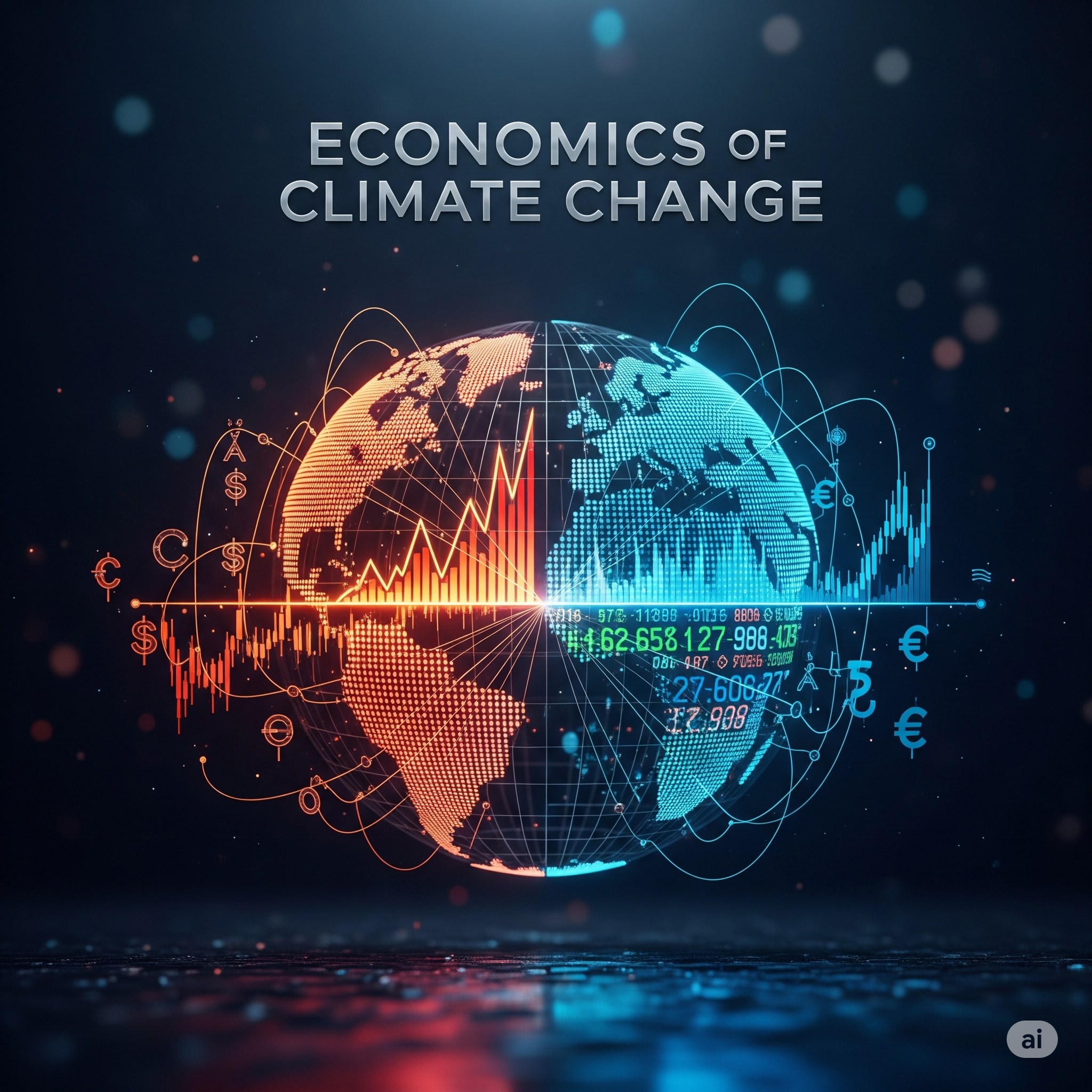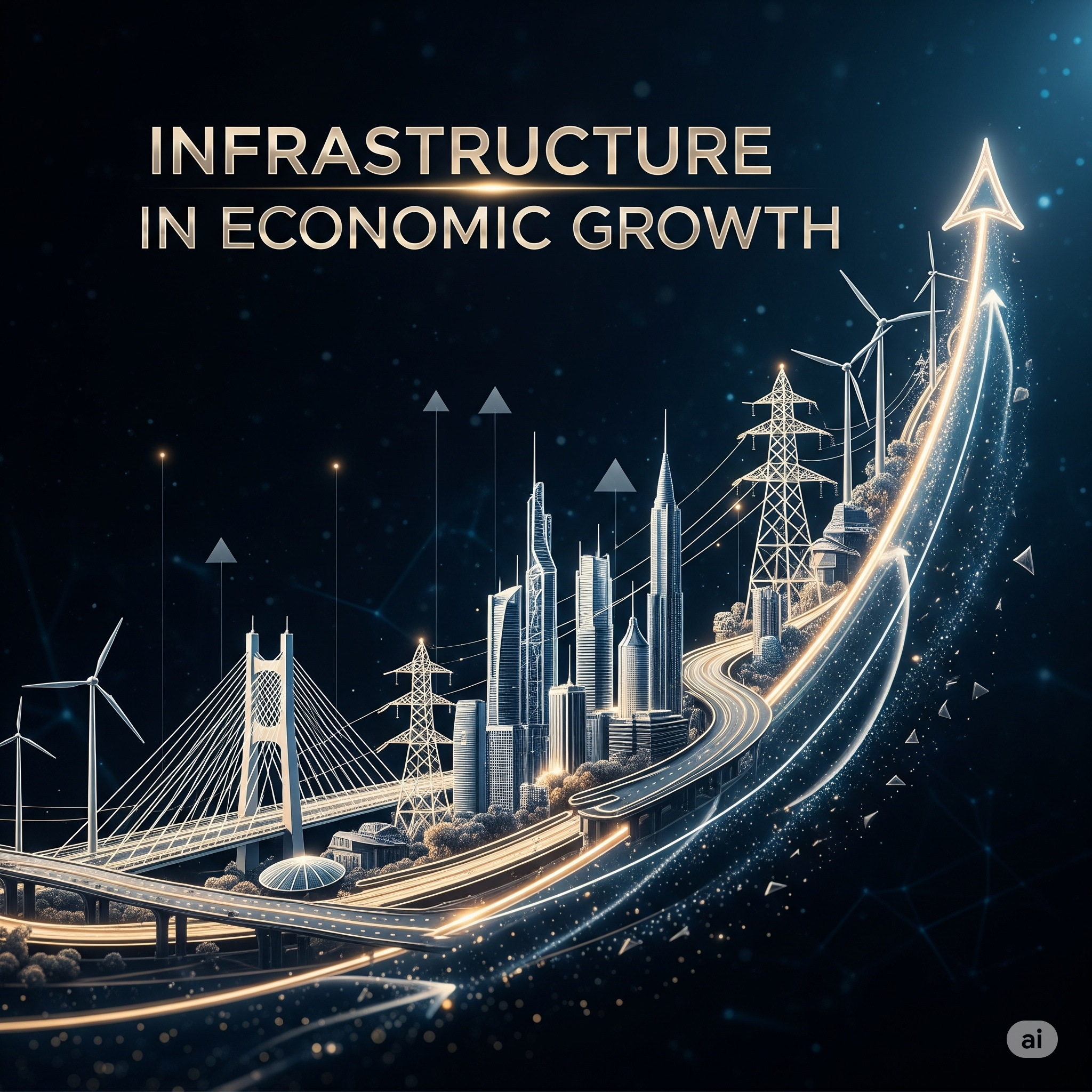Introduction
Climate change is no longer merely an environmental concern; it is a pressing economic issue that affects growth, development, and social welfare worldwide. Rising global temperatures, extreme weather events, sea-level rise, and shifting agricultural patterns have profound economic implications. Understanding the economics of climate change is critical for policymakers, businesses, and society to design effective strategies that mitigate risks, promote sustainability, and ensure equitable growth.
Economic analysis of climate change focuses on understanding the costs of environmental degradation, evaluating the benefits of mitigation, and assessing the impact on production, consumption, trade, and human well-being. This article explores the economic dimensions of climate change, including its causes, consequences, costs, and policy responses, emphasizing the global and developing country perspectives.
Understanding Climate Change
Climate change refers to long-term alterations in temperature, precipitation, and other atmospheric conditions caused by both natural and human-induced factors. Human activities, particularly the burning of fossil fuels, deforestation, and industrial processes, have increased greenhouse gas (GHG) concentrations in the atmosphere, resulting in global warming.
Key Drivers of Climate Change
- Carbon Emissions – Fossil fuel combustion in energy, transportation, and industry.
- Deforestation – Loss of carbon sinks and biodiversity, increasing atmospheric CO2.
- Industrial Processes – Emission of methane, nitrous oxide, and other pollutants.
- Agricultural Practices – Livestock methane emissions, fertilizer use, and land degradation.
Economic Impacts of Climate Change
Climate change affects economies through multiple channels, influencing both short-term productivity and long-term development prospects.
1. Agricultural Productivity and Food Security
- Altered rainfall patterns, droughts, and floods reduce crop yields.
- Changes in temperature affect the suitability of land for specific crops, threatening food supply.
- Increased costs of irrigation, pest control, and crop insurance affect farmers’ incomes.
2. Water Resources and Energy Supply
- Glacial melt, changing river flows, and unpredictable rainfall affect water availability.
- Hydroelectric power generation and industrial water use face disruptions, increasing energy costs.
- Water scarcity can hinder industrial and agricultural growth, leading to regional economic disparities.
3. Health and Labor Productivity
- Heatwaves, vector-borne diseases, and malnutrition reduce labor productivity.
- Increased healthcare costs divert public and private resources.
- Poor health outcomes reduce workforce participation, affecting economic growth.
4. Infrastructure and Property Damage
- Rising sea levels and extreme weather events damage roads, ports, buildings, and energy infrastructure.
- Repair and reconstruction increase government expenditure and divert resources from development.
- Coastal economies and urban centers face higher vulnerability due to population density and investment concentration.
5. Trade and Global Supply Chains
- Climate events disrupt transportation and logistics, affecting trade flows.
- Countries dependent on climate-sensitive exports face income volatility.
- Insurance and risk management costs for global supply chains rise, affecting competitiveness.
6. Migration and Social Stability
- Climate-induced displacement of populations creates economic pressures on urban centers and neighboring regions.
- Loss of livelihoods and competition for scarce resources can trigger social unrest and political instability.
Estimating the Economic Costs of Climate Change
Economic analysis quantifies climate change impacts to inform policy decisions. These costs are generally divided into direct, indirect, and macro-economic costs.
- Direct Costs – Damages to infrastructure, housing, agriculture, and health services.
- Indirect Costs – Loss of productivity, decreased labor supply, reduced trade, and changes in investment patterns.
- Macro-Economic Costs – Slower GDP growth, higher fiscal deficits, and increased inequality.
Integrated Assessment Models (IAMs)
Economists use IAMs to simulate interactions between climate systems and economic activity, estimating the costs of inaction versus mitigation. Prominent models include:
- DICE (Dynamic Integrated Climate-Economy Model)
- FUND (Climate Framework for Uncertainty, Negotiation, and Distribution)
- PAGE (Policy Analysis of the Greenhouse Effect)
These models provide insights into the social cost of carbon, optimal carbon pricing, and long-term policy strategies.
The Concept of Social Cost of Carbon
The social cost of carbon (SCC) estimates the economic damage caused by emitting one additional ton of CO2 into the atmosphere. SCC considers:
- Reduced agricultural productivity
- Health impacts
- Property and infrastructure damage
- Ecosystem service losses
SCC informs carbon pricing, taxation, and investment decisions, incentivizing reductions in emissions and promoting sustainable economic practices.
Mitigation Strategies and Their Economic Implications
Mitigation strategies aim to reduce GHG emissions, improve energy efficiency, and transition to a low-carbon economy. Economic analysis evaluates the costs and benefits of these strategies.
1. Renewable Energy Adoption
- Solar, wind, hydro, and bioenergy reduce reliance on fossil fuels.
- Initial investment costs are high, but long-term benefits include reduced fuel expenses and carbon emissions.
- Renewable energy deployment creates jobs, stimulates technological innovation, and attracts investment.
2. Energy Efficiency Measures
- Retrofitting buildings, improving industrial processes, and promoting electric vehicles lower energy consumption.
- Energy efficiency reduces operating costs and enhances competitiveness.
3. Carbon Pricing and Taxes
- Carbon taxes and cap-and-trade systems internalize environmental costs.
- Encourages businesses and consumers to adopt cleaner technologies.
- Generates revenue that can be reinvested in green infrastructure and social programs.
4. Reforestation and Carbon Sequestration
- Afforestation and soil management capture carbon, mitigating climate change.
- Provides additional income opportunities through ecosystem services and carbon credits.
5. Climate-Resilient Infrastructure
- Investments in flood defenses, drought-resistant agriculture, and resilient urban planning reduce vulnerability.
- While costly upfront, long-term savings in avoided damages justify the investment.
Adaptation Strategies and Economic Considerations
Adaptation involves adjusting systems and practices to reduce climate vulnerability. Economic considerations include cost-effectiveness and equitable resource allocation.
- Agricultural Adaptation – Crop diversification, irrigation improvements, and climate-smart farming practices.
- Water Management – Rainwater harvesting, efficient irrigation, and desalination to address scarcity.
- Health Systems Strengthening – Expanding healthcare access and disease prevention measures to reduce economic losses.
- Urban Planning – Resilient housing, drainage systems, and disaster preparedness reduce property damage and economic disruption.
Climate Change and Developing Economies
Developing countries face unique economic challenges due to climate change:
- High Vulnerability – Dependence on agriculture, limited adaptive capacity, and weak infrastructure increase exposure.
- Limited Financial Resources – Funding for mitigation and adaptation is constrained, requiring international support.
- Potential for Growth Trade-Offs – Investments in climate resilience may compete with short-term development goals.
International mechanisms such as the Green Climate Fund (GCF) and climate-related aid aim to support developing countries in balancing growth and sustainability.
Global Economic Policy Responses
1. International Agreements
- Paris Agreement (2015) – Global commitment to limit warming to below 2°C, with financial and technological support for mitigation and adaptation.
- Kyoto Protocol (1997) – Set binding emission reduction targets for developed countries.
2. Carbon Trading and Markets
- Cap-and-trade systems incentivize emission reductions while allowing economic flexibility.
- Carbon credits generate revenue for green projects and create market-driven incentives.
3. Green Financing and Investment
- Sustainable finance, green bonds, and ESG investments channel capital toward low-carbon projects.
- Encourages private sector participation in climate action.
4. Fiscal and Regulatory Measures
- Subsidies for renewable energy, tax incentives for low-carbon technologies, and penalties for pollution promote a green transition.
- Regulatory frameworks ensure compliance and reduce market uncertainties.
Economic Opportunities in Climate Action
While climate change poses risks, it also offers economic opportunities:
- Green Jobs – Renewable energy, energy efficiency, and environmental management create employment.
- Innovation and Technology – Climate-focused R&D drives technological advancements and global competitiveness.
- Sustainable Agriculture – Climate-smart practices enhance resilience, productivity, and export potential.
- Urban Transformation – Smart cities and resilient infrastructure attract investment and improve quality of life.
Investing in climate action today can yield long-term economic dividends while reducing social and environmental costs.
Conclusion
The economics of climate change underscores the intricate link between environmental health and economic stability. Climate change imposes significant costs on agriculture, health, infrastructure, trade, and social well-being. Developing countries, in particular, face heightened vulnerability due to limited adaptive capacity and dependence on climate-sensitive sectors.
Economic analysis, including the estimation of social costs of carbon and integrated assessment models, provides a framework for evaluating mitigation and adaptation strategies. Policies such as renewable energy adoption, energy efficiency, carbon pricing, climate-resilient infrastructure, and sustainable finance are essential to balance economic growth with environmental sustainability.
Global cooperation through agreements like the Paris Accord, financial mechanisms such as the Green Climate Fund, and domestic policy frameworks enable nations to address climate change while promoting inclusive and resilient economic development. Climate action is not just an environmental imperative; it is an economic necessity that safeguards growth, equity, and prosperity for current and future generations.
By integrating climate considerations into economic planning, countries can transform challenges into opportunities, fostering a low-carbon, resilient, and sustainable global economy.




